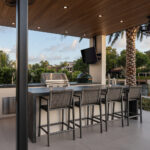Unnaturally Strong
Laminam is not of this world. Not naturally, at least. Instead, Italian engineered stone manufacturer Laminam has created a surface that improves upon natural stone in several meaningful ways.
Of course, for those familiar with engineered stone, it’s not too surprising that engineered stone might surpass the abilities of natural stone. For example, the surface commonly called “quartz,” which is often used as a countertop, is known for being substantially more scratch and stain-resistant than natural stone. Not only does it resist cracking and chipping better than natural stone, but it also doesn’t need to be regularly sealed like natural stone slab countertops do.
However, there is one area where natural stone countertops outperform quartz countertops: Heat resistance. Quartz countertops are fused together with resin, which does not come close to matching the melting point of natural stone like quartzite or granite.
Laminam, on the other hand, does not have a problem with heat. In fact, Laminam slabs have a certified heat resistance of 200 ° C (392 °F), which is the maximum limit reached by EN 438-2 part 16. However, given the production process that involves a firing at about 1220 ° C (2228 °F) the resistance to heat of the slabs can certainly reach higher temperatures.
The Porcelain Stone Revolution
Laminam is part of a new generation of high-tech engineered stones. The manufacturing process at Laminam revolves around an exclusive system to compact carefully selected and refined clays and feldspars; an industrial process that turns our raw material into quartz.
How?
Simple. By outperforming natural stone in every way. If that sounds like hyperbole, let’s break it down and see.

Strength
Strength is almost always a measure of hardness. The harder a stone surface is, the better it will resist scratching, chipping and breaking. Laminam not only offers a superior degree of hardness, but it is actually so strong that it supports extreme slab size options. In other words, Laminam can be produced in extra-large (XL) slabs that are as big as 127.5” x 63.7”. It can also be produced at a thickness of 3/4″, which is just under a half-inch thick.
Laminam is less stiff than natural stone, and its flexibility helps keep it intact while being installed and thereafter. In fact, because it is able to be produced in extra-thin, extra-large slabs, it is actually well-suited to be used in walls or flooring. And Laminam is absolutely ideal for work in high-rises and other places where heavy slabs are impractical.
Which brings up another category where Laminam wins, hands-down: transportability.
Transportability
This is a bit “under the radar” in terms of a feature, but it counts.
Chances are, when you spec stone for an interior design, you probably don’t think much about the condition of the stone new when it’s finally installed. But if you’ve ever had an expensive piece of stone arrive scratched, cracked, or chipped, you almost definitely do. After all, nobody wants to have to hold up a construction job to return and replace a damaged stone slab.
This is where Laminam’s durability really pays off. Sure, it will weather years of use as a wall, floor, or countertop with very little maintenance, but it’s also a product that can withstand the many hazards of transport as well.
Maintenance
Speaking of maintenance, it’s important to highlight just how worry-free Laminam is. Unlike natural stone countertops, which need to be sealed at least twice per year, Laminam requires no sealing.
That’s because Laminam’s surface is non-porous, which makes it highly resistant to staining. It also makes it useful for food preparation because it can hold food hygienically. This not only makes Laminam an excellent surface for kitchen countertops, but also makes it an ideal choice for bathrooms and for use outdoors.
Laminam’s versatility and weather-resistance allows it to go where most natural stone cannot. It can be used around pools, for outdoor bars and countertops, walkways, and more. Laminam does not weather or fade. Chances are, you will be limited more by your imagination than by Laminam’s capabilities.

Style
We can talk at length about how well Laminam performs as a surface in flooring, on a wall, or as a countertop. But, at the end of the day, a stone slab still has to be beautiful enough to be incorporated into an interior design.
Fortunately, Laminam doesn’t skimp here, either. The slabs are available in an expanding variety of styles, from pure white to options that look like granite, marble, or other natural stones. In fact, it looks so good that you’ll probably find it difficult to tell Laminam apart from other natural stones.
And it’s not just on the surface, either. Because it is porcelain stone, it can be etched, beveled, or cut in any way. Just like natural stone. However, because of Laminam’s extreme hardness, you may need to upgrade your tools to cut or etch it.
Cost
You’re probably thinking that if Laminam can outperform virtually every kind of natural or engineered stone, then it must cost as much, if not more than those options. It’s a fair assumption, but it’s not accurate.
Although it is not on par with budget options, Laminam is surprisingly affordable for a surface that can outperform quartz, quartzite, granite, and marble. Especially considering that it is imported from Italy.
And virtually every feature listed above contributes to Laminam’s overall cost-effectiveness. Laminam’s lack of maintenance, durability, and versatility all contribute to make it one of the best values in design today.
The best way to tell is to experience it yourself. Stop into an Opustone showroom today and see for yourself how Laminam is changing the game for engineered surfaces.
Shop for Laminam products now online at opustone.com



